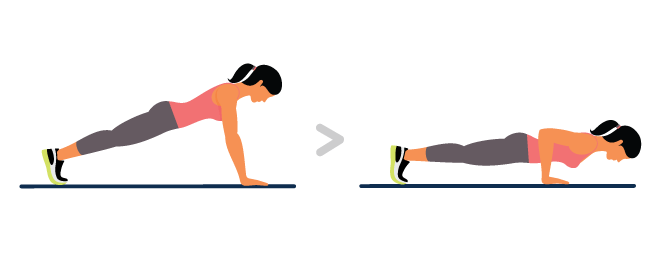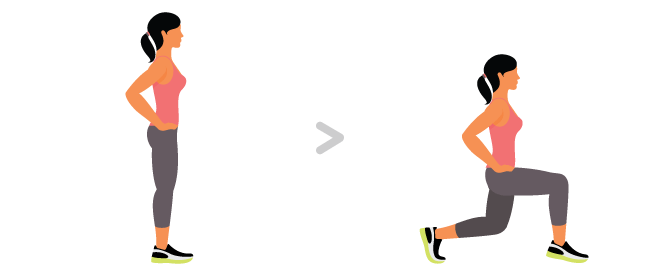Effective equipment-free training
If you don’t have the space—or budget—to create your own home fitness room, don’t worry! You can still work out effectively by making the most of your surroundings.
Strength exercises
The goal of strength exercises is to build up certain muscle groups. There are many exercises that require no special equipment, and can be done using everyday objects like a chair or wall.
To ensure your training program is well-balanced, be sure to do exercises that target different muscle groups, such as :
- Push-ups for chest (pectoral) and arm muscles

- Wall squats (“the chair”) for thigh muscles (quadriceps)

- Crunches for stomach muscles (abdominals)

- Lunges or squats for butt and leg muscles

With strength training, you’ll often hear people talk about series of reps. This refers to the number of times you need to do the exercise. For example, for sit-ups, a series of 8 reps (or repetitions) would mean that you do 8 sit-ups without stopping.
When you do several different exercises, one after the other, this is referred to as circuit training.
It is important to maintain the correct body position and alignment during this kind of exercise, because poor technique can lead to injury. Focus on the quality of the exercises you do rather than the quantity. It’s better to do 5 perfect sit-ups than 10 crooked ones!
Aerobic exercises
Aerobic exercises help improve cardio-respiratory fitness. They target the entire body and consist of continuous movements that vary in intensity depending on individual capacity.
Running on the spot, jumping jacks, and stairs are just some examples of aerobic exercises that can be done indoors without any special equipment. Walking is an excellent outdoor option.

With this type of exercise, you can gradually increase the duration and intensity of the exercise as your fitness improves. Once again, it is best to start out very slowly and gradually build up, to avoid injury.
End your aerobic sessions with a few minutes of cool-down by doing a few low-intensity exercises to allow your body to gradually return to its resting state.
A few tips
- If you suffer from chronic disease, consult your doctor before starting a training program.
- Start out very slowly, and gradually build up. For example, you could start with two sessions a week (strength training on Saturday and aerobic training on Tuesday).
- Gradually add sessions, up to 6 per week (alternate three strength and three aerobic workouts, plus one rest day).
- Begin each workout with a warm-up that lasts a few minutes (gently move all your limbs to prepare them for the workout), but avoid stretching at this time. Stretching can be incorporated during or at the end of your workout.
- If you’re not sure where to start, try downloading one of the many fitness apps available online, e.g., Nike Training Club.
Happy training!
